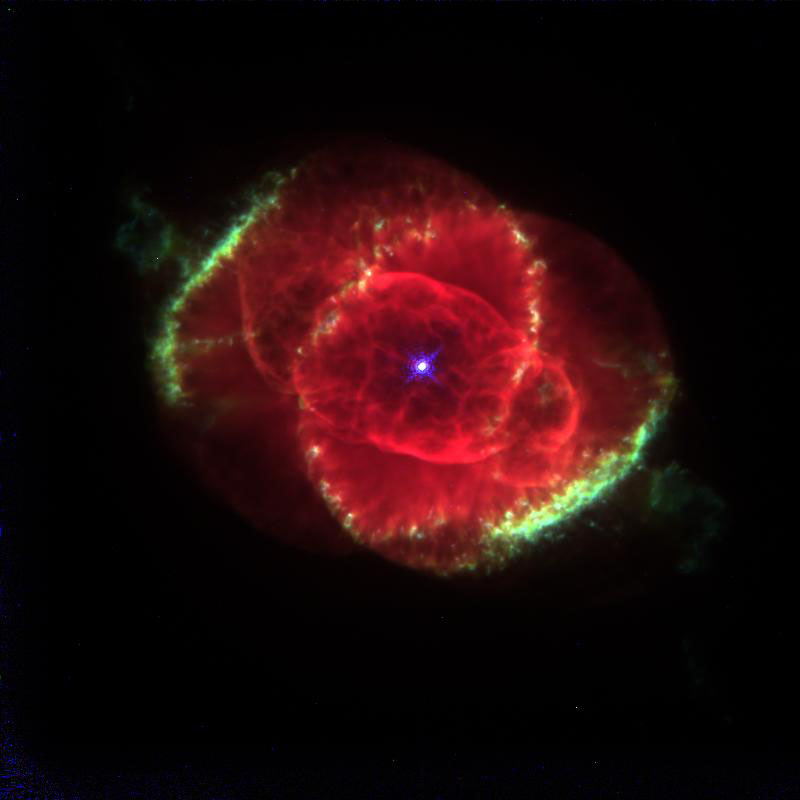
Conspiracy theorists are abuzz over the revelation that a recent NASA photo was touched up before being released to the public.
But this is not news, or evidence that the space agency has something to hide. NASA routinely processes raw images to enhance details, or to visualize things the human eye could never see, agency officials have said. Other space agencies, and many astronomers, do the same thing.
Such editing lets scientists and the public gain a better understanding of the structure of celestial objects — and a better appreciation of their beauty. [Images from the Hubble Space Telescope]
Cassini's image: tempest in a teapot
The controversy flared up last week, when a conspiracy theorist noticed black smudges on the edge of a photo NASA's Cassini spacecraft had taken of two Saturn moons, Titan and Dione. The allegation: someone had altered the image.
And indeed someone had. Cassini's digital camera takes pictures through three different filters: red, blue and green. These separate, sequential images are later combined to create a composite, true-color photo.
In the time that elapsed between the three photos, Dione moved slightly. To create the final picture, Emily Lakdawalla of the Planetary Society, a nonprofit space advocacy organization, aligned the two moons, then Photoshopped in some missing bits of shadow.
Get the Space.com Newsletter
Breaking space news, the latest updates on rocket launches, skywatching events and more!
Scientists and technicians commonly do this sort of digital manipulation on space images, according to NASA officials.
Hubble photos: a case study
Take, as an example, photos beamed back to Earth by the Hubble Space Telescope, which has been imaging the cosmos since 1990. Many of these images are processed or edited, as SPACE.com reported back in 2002.
Like Cassini, Hubble takes separate, digital color images through red, blue, green and other filters. Scientists can combine these photos to create a comprehensive picture. Often, this image is a close approximation of what people would see if they could get close enough to the object in a spacecraft.
Sometimes, however, scientists enhance certain colors to draw out fine details of structure. For example, Hubble photographed the Cat's Eye Nebula through three narrow wavelengths of red light that correspond to radiation from hydrogen atoms, oxygen atoms and nitrogen ions (nitrogen atoms with one electron removed).
For human eyes, those three wavelengths of light would be difficult to distinguish. So the scientists assigned red, blue and green colors to them and combined them to highlight the subtle chemical differences.
Hubble also has other filters that pick up wavelengths of light humans can't see, like ultraviolet and infrared. To process images taken through these filters, scientists assign colors to represent the invisible light.
Hubble took these images of the Egg Nebula, for example, in visible and infrared light. In the infrared version, blue corresponds to starlight reflected by dust particles around a dying star, and red represents heat radiation emitted by hot molecular hydrogen, researchers said.
The processed infrared image helps researchers, and the public, understand what's happening in the Egg Nebula. A dying star is blasting jets of gas and dust into space at high speeds. The enhanced image provides insights into stellar structure, and it yields clues about what happens during a star's dying days, scientists said.
Join our Space Forums to keep talking space on the latest missions, night sky and more! And if you have a news tip, correction or comment, let us know at: community@space.com.

Michael Wall is a Senior Space Writer with Space.com and joined the team in 2010. He primarily covers exoplanets, spaceflight and military space, but has been known to dabble in the space art beat. His book about the search for alien life, "Out There," was published on Nov. 13, 2018. Before becoming a science writer, Michael worked as a herpetologist and wildlife biologist. He has a Ph.D. in evolutionary biology from the University of Sydney, Australia, a bachelor's degree from the University of Arizona, and a graduate certificate in science writing from the University of California, Santa Cruz. To find out what his latest project is, you can follow Michael on Twitter.









